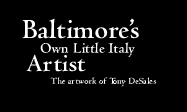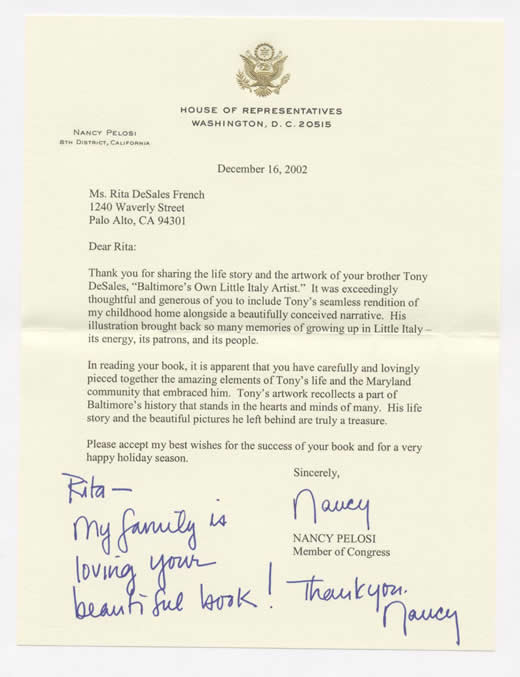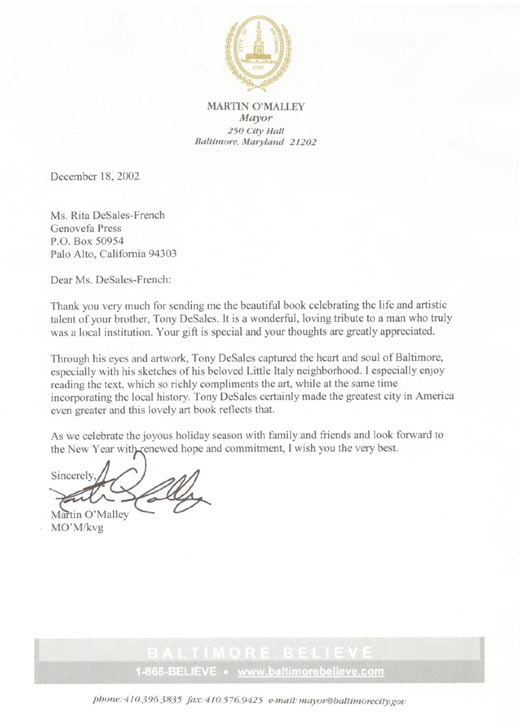
|
Reviews American Italian Historical Association Newsletter Comments
Corrections |
|
Larry DiStasi Rita DeSales
French, Baltimore’s Own Little Italy Artist: The Artwork of Tony DeSales,
Genovefa Press: 2003. DeSales’
sister, Rita French, along with her husband, Perrin French and designer Irvin
Lin, have made of this life story one of the finest self-published books you
are likely to see. Like Tony DeSales’ life itself, the book is a labor of
love. Its inside cover is decorated with the postcards DeSales received over
a lifetime. Then there is a short sketch of Tony DeSales’ life, which reads
like a novel. The main portion is filled with the drawings he did, often
with simple ball-point pens, all lovingly rendered, and described. The drawings
and descriptions tell the history not only of Little Italy—though there
is a great deal of that—but also of Baltimore, one of America’s oldest, and
most architecturally interesting cities. And since DeSales took numerous
trips to his favorite cities nearby—Annapolis and Washington, DC—there are
sections with drawings of those cities as well. Many of the drawings have
photographs of the buildings on the facing pages for comparison. Some have
Tony’s handwritten comments along the bottom, such as the one of “Little
Italy--Stiles & Albemarle...Look down these old streets for their proud
or hidden histories, for the record of our joys and tragedies...” To get
a copy, contact Rita French at (650)324-0575, or by email at ritaf@aol.com.
Baltimore
City Paper Tony Award For more than 35 years, a neatly dressed man sat at an easel at Fawn and High streets in Little Italy, drawing and painting scenes of Baltimore and Maryland. Handsome and dignified, Tony DeSales was a full-fledged Baltimore character, hailed by restaurant patrons and lifelong neighbors, dubbed Little Italy's "ambassador" by journalists and politicians. During his tenure on the street corner, DeSales turned out hundreds of drawings, mostly postcard-like images of local landmarks, rendered with a ballpoint pen on inexpensive paper, then variously copied and/or hand-tinted. Over the same years--the last third of the 20th century--DeSales also wrote and published a community newsletter called Piccolo, dabbled in poetry, composed organ music for the Church of St. Leo, and passed out hundreds of self-published, self-addressed postcards that were mailed back to him from all over the world. From 1966 to 1998, his mother, Genevieve, often sat near him on the sidewalk as he worked. DeSales died in 2000 at the age of 59. Applied to an eccentric public person, the term "character" expresses affection but, at the same time, diminishes the actual person: The character himself is at risk of becoming a scrap of local color, a living stereotype. Earlier this year, Rita DeSales French rescued her brother's memory from one-dimensionality by publishing, at her own expense, the hefty book Baltimore's Own Little Italy Artist: The Artwork of Tony DeSales. Like DeSales' meticulous renderings of his built environment, the book is a labor of love. The title is a bit misleading. The 225-page tome, of coffee-table proportions, displays 100 or so reproductions of DeSales' drawings and watercolors, but the accompanying text isn't really about the artwork. Instead, it's about DeSales himself and his subject matter--buildings, monuments, scenery, and sailing ships. As a compilation of local lore, this one belongs on the Baltimore bookshelf alongside Bert Smith's collections of local postcards, Frank Shivers' walking tours, and that hard-to-find, out-of-print collection of Charmed Life essays. The brisk, literate prose accompanying DeSales' drawings--plus dozens of lovely photographs and a few window-screen paintings by Tom Lipka --amounts to a respectable Bawlmer guidebook. French and her co-authors draw on many sources, yet manage to boil the copious material down to its most interesting essentials and gemlike factoids. (For example, do you know the connection between Little Italy's annual St. Anthony's festival and the Great Baltimore Fire of 1904? During the fire, the community prayed to the saint en masse for protection, and--lo!--the flames never crossed Jones Falls. Thankful Little Italy has held the festival ever since.) DeSales' life story, tersely related here, is a heartbreaker: the tragedy of a man with native talent and a restless spirit who, due to poverty and his own stubborn integrity, never got to develop his gifts fully. As the eldest son of a mentally ill mother and a father who drifted away from the family, he shouldered household responsibilities from an early age. DeSales is quoted as saying "I was born 40 years old to take care of my mother." He also took care of his siblings. His hard-won career as a math teacher was cut short in the early '60s by his decision to care for his mother at home rather than let her languish in a nursing facility. For the rest of his life he was, as the authors assert, truly an "outsider artist" by virtue of being self-taught and self-directed. He was never the sort of mystic naif displayed at the American Visionary Art Museum. Instead, his drawings were intended to be faithfully descriptive. He was more concerned with the exact number of panes in a window than with the vagaries of natural light and shade. Even so, the art allows some insight into the soul of the artist--his personal rigor, his fixation on the solid, reliable facts in the slippery world around him. Although the writers remark that he nearly always included people in his scenes, the cityscapes look lonely, with small, scattered figures, often in silhouette. Meanwhile, light, shade, and atmosphere become free-form decorative patterns that dance around the hard-edged, obsessively detailed buildings. Aesthetically, some of the most pleasing drawings represent the least beautiful buildings, such as La Fontaine Bleu catering hall in Glen Burnie, where large glass surfaces gave DeSales an excuse to go wild with imaginary reflections. As a small-time, largely self-taught artist myself--and one who has counted his share of window panes--I can't help but feel a pang of empathy for Tony DeSales. Success, in the world's terms, is an odd interaction of talent, ambition, perseverance, and sheer luck. One's dice start shaking before one's life begins. What would Tony DeSales have become, given different place and time of birth, given different parents? A classical musician? A commercial artist? A high school principal? Instead, he got some raw deals--and in his own dignified, creative way, he triumphed over them. More than being "a character," he had character. In the end, that's what justifies the book. It's doubtful that a happier, more conventional life would have garnered such a tribute. As of this writing, Baltimore's Own Little Italy Artist is one of three finalists for a Benjamin Franklin Award in the category of biography and memoir. The awards will given out on May 28 by the Publishers Marketing Association, an organization of independent publishers. © 2003 Baltimore City Paper. All Rights Reserved. for more about Baltimore by Tom Chalkley, visit the archives at www.citypaper.com
Hopkins Medical News Spring/Summer 2003 Baltimore’s
Own Little Italy Artist: The artwork of Tony DeSales If you’re from the part of Baltimore where immigrants lived in rowhouses lining the harbor to be close to the shipyards and canneries where they worked, at a time when screens were painted with scenes of swans and waterfalls, and marble steps gleamed white from regular treatment with Ajax and a scrub brush, then something about this book will grip at your throat. There’s love and quirkiness emanating from this lush coffee table book—a mood entirely fitting its subject. The 225-page volume is a tribute to “Baltimore institution” Tony DeSales, a self-taught artist who worked on the corner of Fawn and High Streets in Little Italy for 35 years. His drawings, rendered with colored pencils and Bic pens, are architectural scenes where the perspective sometimes goes awry; there’s a slight Van Gogh quality to them. The book begins with a brief but well-done biography of Tony’s hardscrabble life, lovingly written by his sister, Rita DeSales French. We learn that Tony, one of five children of first generation Polish and Italian immigrants, not only took care of his siblings but spent a lifetime looking after his mother, who suffered with schizophrenia. Each of the drawings is accompanied by historical information written by Rita’s husband, Perrin L. French (M.D. 1968). Even Baltimore natives will learn a lot here. For example, the idea for painted screens began with an East Baltimore grocer and artist with a practical problem—he needed to shade his wares from the sun. Tony DeSales died in 2000, at the age of 59, after burying his mother just two years earlier. It seems that he managed to meet just about everyone—from governors, senators and movie stars to ordinary folks—at his carefully selected corner in Little Italy where four famous restaurants met. His sister, Rita, thinks that was the point. “How does a talented young boy find expression for his artistic gifts with no support from anyone?” she writes. “He turned himself over to the people of Baltimore. He sought out their notice and their praise—he wanted them to love him. And what did the people of Baltimore do? They loved him back.”
Comments "Baltimore’s Own Little Italy Artist — the Artwork of Tony DeSales arrived today. I had a chance to look it over tonight, and it is beautifully done! I very much like many of the more intricate (detailed) of Tony’s drawings (Baltimore, Little Italy, Fells Point, Annapolis, Wash DC, & other locations). One really gets a feeling for the man–a good man, community man, a people-person, a man who took care of his mother lifelong, a man who loved his surroundings, as depicted in his drawings. Rita did a beautiful job of putting this together–the artwork, the photographs, the biographical element and the descriptions of Baltimore neighborhoods & landmarks (and other). Furthermore, I am pleased with the way my photographs and credit came out. I am impressed with the product that one woman (Rita, along with her two co-authors), working independently, can produce." — Keith Stanley
"From Baltimore's Own Little Italy Artist - The Artwork of Tony DeSales, one gets a sense of the special character of communities and neighborhoods in and around Baltimore -- Little Italy, Fells Point, Annapolis, Washington, D.C. The drawings, accompanied by rich historical text, depict the special architecture of neighborhoods, houses, churches, and a variety of institutions, as well as life on the water. The book serves as a valuable resource to anyone wanting to gain a full appreciation of life in Baltimore and its surrounding areas." — Freeman Hrabowski, President, University of Maryland, Baltimore County
A
Warm Visual Embrace of Baltimore's Little Italy — Ilo Soovere
from Perry Point, Md Although I am not usually an art fan, I found this book to be a delightful view into the life and work of Tony DeSales. If you love Baltimore (as I do) then this book is for you. The many drawings and photographs of local landmarks will give you a different view that only Tony DeSales can provide. This is a great book! — Gilbert M
Bohannon Jr from Baltimore, MD USA Rita: I am the Historian for the USS SHANGRI-LA Association and just finished a book on the history of our aircraft carrier. Although I was really happy (and relieved) when that project was completed, it was not until I began to receive feedback from our members, that I realized what an impact such a project can have on people. I showed your book to several other Shrewsbury neighbor's who are Baltimore natives. They were elated and immediately wanted to know how to get a copy. They also shared stories about seeing or talking to Tony on the street corner. Not only have you preserved a special part of Baltimore's history, you have also produced a 'Family Album' for those who grew up in and around Baltimore. As we said in the Navy, Bravo Zulu (Well Done). Sincerely,
Corrections The Star-Spangled Banner in the collection of the Star-Spangled Banner Flag House in Baltimore is a replica created in 1964 for the World's Fair in New York City. The original Star-Spangled Banner was given to Major George Armistead, commander of Ft. McHenry, after the bombardment in 1814. The flag was kept by the Armistead family until July 6, 1907 when it was given to the Smithsonian Institution. The flag is currently undergoing restoration at the National Museum of American History. You can actually see the flag as its being restored at the museum. It's a pretty fascinating display if you get a chance to visit! — Eric Voboril, Star-Spangled Banner Flag House
Please send comments and corrections to genovefapress@aol.com |






